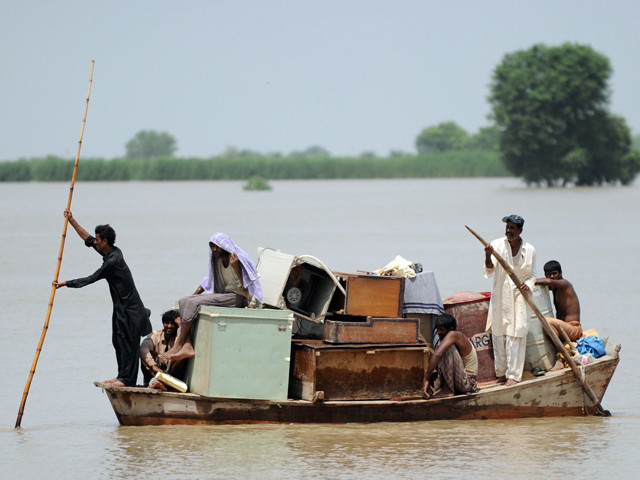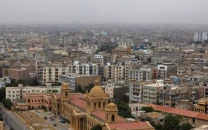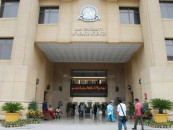Shattering Noah’s Ark
All at once, hundreds of animals, birds and insects were left without shelter or food.

These animals, however, might make their presence felt as many of them are headed towards towns and cities. According to Rohri residents, three bewildered boars were seen near the Lance Down bridge on Wednesday. Making their way into Rohri city, the boars hid in bushes near some ponds, where they were hunted down with the help of dogs. Two of the boars were killed while the other managed to escape. The ponds were a source of water for the residents. But now they are staying away from the ponds, thinking the boars might have contaminated them.
The floods have ravaged riverine forests near the Indus, where many species of wildlife live, causing these animals to move out. Environmental experts stress that if the Sindh wildlife department does not take initiatives to conserve these animals and their environment, some of the species might be pushed towards extinction.
The vegetation in the kachcha areas from Kashmore to Thatta is thronged with animals, including the hog deer, black buck, chinkara, fishing cat, caracal, jungle cat, jackal, small Indian civet, wild boar, hare, hedgehog, common mongoose and several kinds of snakes.
The ignored flood survivors
“When the flood swept into a forest near Mitiani in Naushero Feroz, people spotted some hog deer scampering out of the forest,” sources in the wildlife department reported. “The deer took shelter in sugarcane fields nearby but some people went into the fields and killed two of them.”
Residents of Keti Jatoi in Dadu district said hog deer were spotted on some islands in their area, adding, “Poachers have already started arriving here for the hunt.”
The hog deer is an endangered animal and its hunting is strictly prohibited. According to Altaf Abro, Manger Conservation World Wildlife Fund-Pakistan (WWF-P), the hog deer is a nocturnal animal with short legs and a stocky appearance. When alarmed, the deer make a whistling sound or give out a warning bark. Abro said the deer can swim well and are not afraid of entering water, which is why they often take temporary shelter on islands between the channels of the Indus. But after the floods, most of these islands were completely submerged, causing the deer to come into settlements. Many other mammals and reptiles have been affected by the devastation wrought by the floods.
The floods have not just destroyed the habitat of animals, but will cause long-term repercussions for them. Outbreak of diseases is feared that is likely to crank up the mortality rate, said the deputy conservator wildlife department, Dr Fahmida Firdous.
Birds too have been affected since their nesting and breeding grounds were damaged in the floods, a big blow to reproduction and natural conservation, she said.
Meanwhile, floods have also caused problems for dolphins in the Indus River between Guddu and Sukkur barrages since the breach at Tori bund led to a large inflow of water into Kashmore, Shikarpur and Jacobabad areas. “Many dolphins might have been washed away into these areas,” said Firdous.
Abro explained that most of these animals found in riverine forests live in pairs. When a disaster such as a flood occurs, animals panic. In their attempt to run away, the males and females are separated. “This greatly hampers the reproduction process,” he said, adding that being wrenched out of their original habitat means the animals have to suffer different temperatures, a lack of routine, disturbances in their food and so on.
Saving steps
Firdous said the department has started a survey to assess damage to the environment in areas between Kashmore and Thatta.
They have also alerted their filed staff to protect animals from hunters and to spread awareness among residents about the dangers posed to these animals and ways to help them.
Zain Daudpoto is the executive director of the Indus Development Organisation, which has been working for conservation of forests in Hyderabad for several years. According to him, when floodwater entered Khebrani and Raes Mureed forests in Matiari district, several animals such as wild rabbits, jungle cats and hog deer came out into villages.
“With the help of other villagers and volunteers we saved seven hog deer and 27 wild rabbits,” he said.
Taking the animals inside the Khebrani forest, the volunteers released them on an island in the middle of the forest. Most of the forest was completely flooded, with trees as high as 20 feet submerged in water almost to the top. “We went in by boats,” Daudpoto said, adding that they saw dozens of snakes curled up on the tops of the trees, which were just visible above the water.
Animal habitats in the ketis on both sides of the Indus River, including Keti Mumtaz, Keti Pirzada, Keti Pagara, Keti Shah and Keti Jatoi, were inundated with floodwater.
Published in The Express Tribune, August 26th, 2010.



















COMMENTS
Comments are moderated and generally will be posted if they are on-topic and not abusive.
For more information, please see our Comments FAQ